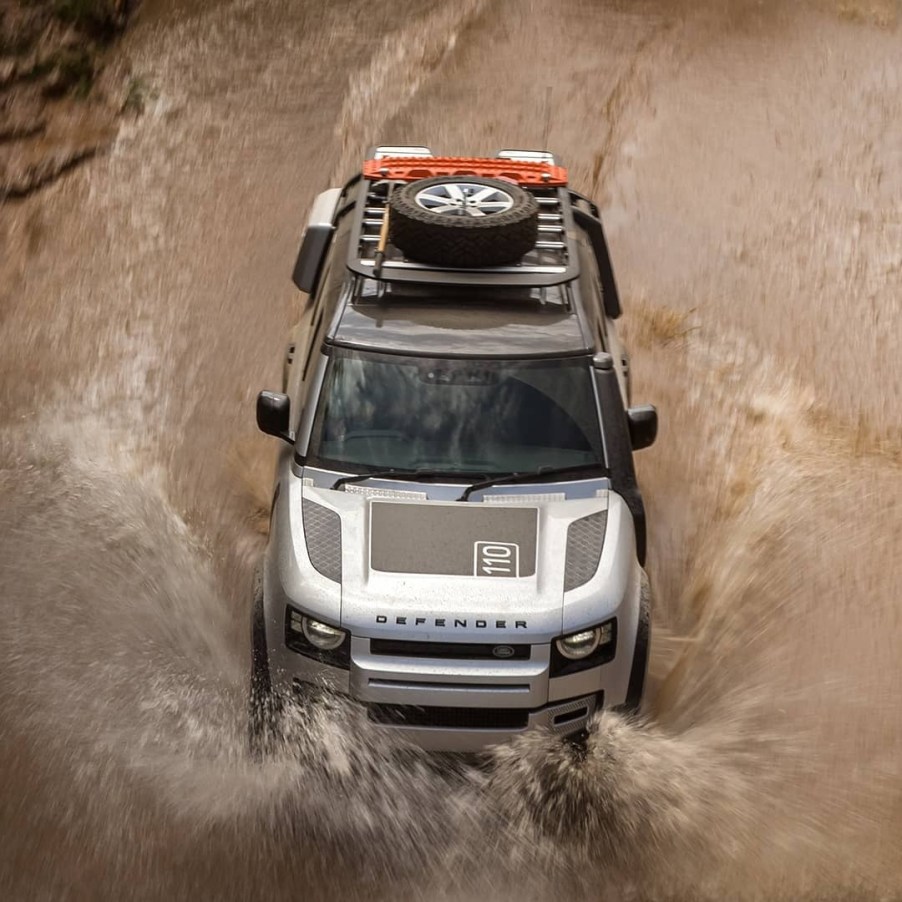
The Land Rover Defender Is a Worthy Successor to an Icon
Updating a beloved vehicle is tough. The teams behind icons like the Porsche 911 and Jeep Wrangler know that very well. Too much change and you risk alienating the fans. Too little, and the car loses sales. Land Rover faced this same challenge when it redesigned the Defender for the modern era. The technical specs and features looked promising on paper. But without a genuine off-road drive, it was tough to see if the Land Rover Defender could live up to its name. But after traversing over Africa, it seems the new SUV can proudly step out of its predecessor’s shadow.
Prepping the Land Rover Defender for an Africa adventure

To test its new Defender, Land Rover turned to Namibia. Over a multi-day, 420-mile excursion, Jalopnik reports, the SUVs would face sand dunes, rocky riverbeds, mud, and water crossings. According to Motor Trend, only 2 of those miles were on paved roads.
For its expedition, Land Rover provided Defender 110s in both gasoline and diesel trim. The US, unfortunately, won’t get the diesel. Instead, we’ll get the P300, with a 296-hp 2.0-liter turbocharged four-cylinder, and the P400 mild-hybrid, with a 395-hp 3.0-liter turbocharged and electric-supercharged six-cylinder. Both Defenders have an 8-speed automatic and four-wheel drive with a two-speed transfer case and locking rear differential. But the powertrain isn’t the only place where Land Rover updated the Defender.
In place of the original’s body-on-frame construction and solid axles, Car and Driver reports, the new Defender is unibody with independent suspension all-around. The Defender also augments its mechanical off-road capabilities with various electronics. Ultrasonic sensors measure water depth, while multiple cameras help the driver spot obstacles. The SUV now offers configurable driving modes, hill descent control, adjustable suspension, and off-road cruise control.

On top of that, the Land Rover Defender 110s were also fitted with a few optional extras. For one, they had the optional air suspension. They were also equipped with a fold-down ladder, off-road tires, skid plates, a Warn winch, and the Explorer Pack. That adds a roof rack, intake snorkel, mudflaps, and an externally-mounted waterproof lockable cargo box.
How did the Land Rover Defender perform off-road?
Overall, the reviewers came away very impressed.
With the air springs, the Land Rover Defender has a ground clearance of 11.5”, and better departure and break-over angles than the Jeep Wrangler Rubicon. It can also wade into water 35.4” deep, Car and Driver reports, vs. the Wrangler’s 30”.
If the independent suspension lessened the Defender’s capabilities, MT couldn’t really tell. However, it did make the ride very comfortable, the air springs undoubtedly also helping. MT reports the handling was on-par with the Fox-shock-equipped F-150 Raptor. Even over rocks and bumpy dirt roads, Jalopnik reports “the ride was almost as smooth as bathwater.”
The Defender 110’s upgraded Terrain Response system includes modes for Sand and Gravel. Although the electronics adjust the throttle response, 4WD system, and suspension to properly put power down to the ground. Drivers had to respect the SUV’s weight, but as long as you’re not being a hooligan, the Land Rover Defender makes off-roading a breeze.

The Land Rover Defender’s interior is also well-executed. There’s an optional 3rd front seat available that can fold down into a center console and armrest. Instead of a traditional dashboard, there’s a magnesium beam/spar, which also houses the infotainment touchscreen. This design improves road visibility, and also makes for abundant storage. The seats are also all-day comfortable, Car and Driver reports.
Where it still needs work
That being said, the Land Rover Defender isn’t perfect.
The SUV has brake-by-wire, due to the hybrid powertrain, and somewhat difficult to modulate. The P400’s throttle is also somewhat laggy at low speeds, though MT reports the electric supercharger does help once you get going. The infotainment can also be somewhat annoying, Jalopnik reports, with multiple menu selections required to get the click-wheel to do something simple like change the driving mode.
Car and Driver also noticed some electrical gremlins during in its Defenders. Admittedly, these were pre-production SUVs. It doesn’t bode well, though, if Land Rover wants to shake its reputation.

In addition, the Land Rover Defender can get pricey rather quickly. The 2-door Defender 90 starts at $45k, while the 4-door Defender 110 starts at just under $50k. However, Jalopnik reports the Defender 110 P400s used in Africa would ring in at about $73k. That’s almost Toyota Land Cruiser money, and the Land Cruiser is more spacious and arguably more reliable.

But, Jalopnik estimates a reasonably well-equipped off-road-ready Defender 110 P300 could be had for about $57k. That’s still about $15k more than a base Wrangler Rubicon, but it’s less than a Toyota 4Runner TRD Pro. And the Land Rover Defender is both more luxurious and modern than the 4Runner while being significantly safer and more comfortable than the Wrangler.
The Land Rover Defender isn’t the bare-bones, old-school SUV its predecessor was. But it is an SUV that could travel anywhere, on- or off-road, in comfort and style. And that is definitely worthy of praise.
Follow more updates from MotorBiscuit on our Facebook page.


